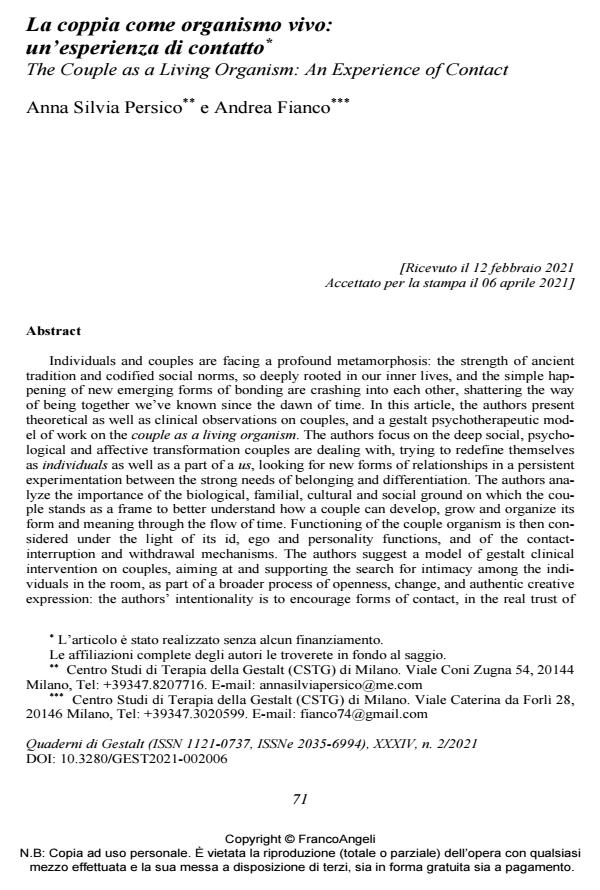The Couple as a Living Organism: An Experience of Contact
Journal title QUADERNI DI GESTALT
Author/s Anna Silvia Persico, Andrea Fianco
Publishing Year 2021 Issue 2021/2
Language Italian Pages 16 P. 71-86 File size 218 KB
DOI 10.3280/GEST2021-002006
DOI is like a bar code for intellectual property: to have more infomation
click here
Below, you can see the article first page
If you want to buy this article in PDF format, you can do it, following the instructions to buy download credits

FrancoAngeli is member of Publishers International Linking Association, Inc (PILA), a not-for-profit association which run the CrossRef service enabling links to and from online scholarly content.
Individuals and couples are facing a profound metamorphosis: the strength of ancient tra-dition and codified social norms, so deeply rooted in our inner lives, and the simple happening of new emerging forms of bonding are crashing into each other, shattering the way of being together we’ve known since the dawn of time. In this article, the authors present theoretical as well as clinical observations on couples, and a gestalt psychotherapeutic model of work on the couple as a living organism. The authors focus on the deep social, psychological and affective transformation couples are dealing with, trying to redefine themselves as individuals as well as a part of a us, looking for new forms of relationships in a persistent experimentation between the strong needs of belonging and differentiation. The authors analyze the importance of the biological, familial, cultural and social ground on which the couple stands as a frame to better understand how a couple can develop, grow and organize its form and meaning through the flow of time. Functioning of the couple organism is then considered under the light of its id, ego and personality functions, and of the contact-interruption and withdrawal mechanisms. The authors suggest a model of gestalt clinical intervention on couples, aiming at and support-ing the search for intimacy among the individuals in the room, as part of a broader process of openness, change, and authentic creative expression: the authors’ intentionality is to encourage forms of contact, in the real trust of the beauty of the us, and in the real trust of a couple organ-ism able to self-regulate, change and grow through time in deep knowledge of each other, respect and appreciation for the vital growth of the I-Thou relationship.
Keywords: Gestalt Couple Therapy, social ground, couple organism, intimacy, I-Thou rela-tionship.
Anna Silvia Persico, Andrea Fianco, La coppia come organismo vivo: un’esperienza di contatto in "QUADERNI DI GESTALT" 2/2021, pp 71-86, DOI: 10.3280/GEST2021-002006